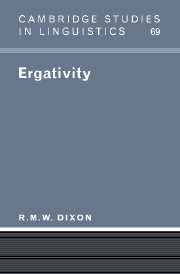Book contents
- Frontmatter
- Contents
- Preface
- Acknowledgements
- Appeal
- List of abbreviations
- 1 Introduction
- 2 Syntactically based and semantically based marking
- 3 Intra-clausal or morphological ergativity
- 4 Types of split system
- 5 The category of ‘subject’
- 6 Inter-clausal or syntactic ergativity
- 7 Language change
- 8 The rationale for ergativity
- Appendix: A note on theoretical models
- References
- Index of authors
- Index of languages and language families
- Subject index
4 - Types of split system
Published online by Cambridge University Press: 06 July 2010
- Frontmatter
- Contents
- Preface
- Acknowledgements
- Appeal
- List of abbreviations
- 1 Introduction
- 2 Syntactically based and semantically based marking
- 3 Intra-clausal or morphological ergativity
- 4 Types of split system
- 5 The category of ‘subject’
- 6 Inter-clausal or syntactic ergativity
- 7 Language change
- 8 The rationale for ergativity
- Appendix: A note on theoretical models
- References
- Index of authors
- Index of languages and language families
- Subject index
Summary
Many languages mix nominative–accusative and absolutive–ergative types of intra–clausal marking. This chapter surveys the kinds of factor that condition these splits. They can relate to the semantic nature of the main verb (§4.1), to the semantic nature of the core NPs (§4.2), to the tense or aspect or mood of the clause (§4.3), or to the grammatical status of a clause, whether it is main or subordinate, etc. (§4.4). Some languages show just one conditioning factor while others combine two or more of the parameters (§4.5).
Split conditioned by the semantic nature of the verb
There must be contrastive marking for A and O (if a transitive clause is not to be ambiguous). In §3.3 we discussed ways in which S is like A, and other ways in which S is like O, in terms of universal semantic and discourse features and universal grammatical properties. This appears to be the major explanation for the rarity of tripartite systems, where S is marked differently from both A and O. There are pressures to identify S with A (as in an accusative language) or S with O (as in an ergative language). And some languages pursue a middle course, marking some S like A and some like O; such languages fall into two kinds, ‘split-S’ and ‘fluid-S’.
Information
- Type
- Chapter
- Information
- Ergativity , pp. 70 - 110Publisher: Cambridge University PressPrint publication year: 1994
